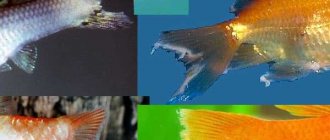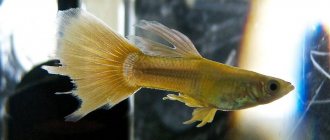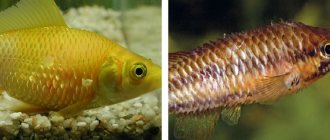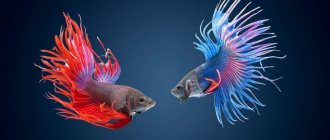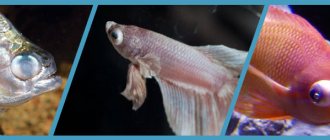Description of the disease
This disease is of bacterial origin and is highly contagious. The main culprits of its development are considered to be pathogenic bacteria Aeromonas punctata and Pseudomonas fluorescens.
Bacteria of the genus Aeromonas are anaerobic rods, that is, both a small amount and the complete absence of oxygen are sufficient for their vital activity. Pseudomonas fluorescens —
The organisms are an aerobic species and therefore require oxygen to develop, but some strains may use nitrates instead of oxygen. Regardless of the genus, both bacteria live in both fresh and brackish water.
A common sign of infection is red spots on the fish's body and fins. Without treatment, the disease progresses very quickly and leads to the death of the inhabitants of the aquarium/pool. Therefore, it is important to notice the first signs of infection in time and prevent its spread.
It is difficult to cure young fish; the mortality rate among them from this disease is high. Adults recover more often, but their fin shape is not restored - they remain shortened with uneven edges, their rays are broken and knotted. If the ulcers spread to the body, then most likely the individual will die.
First of all, check how your fish breathe!
Often aquarium fish die because the water parameters have changed.
The most destructive effect on them is the low level of oxygen in the water. The characteristic behavior is that most of the fish stand on the surface of the water and swallow air from it. If the situation is not corrected, then after a while they begin to die.
At the same time, such situations can occur even among experienced aquarists! The oxygen content of water depends on the temperature of the water (the higher it is, the less oxygen is dissolved), the chemical composition of the water, the bacterial film on the surface of the water, an outbreak of algae or ciliates.
You can help with partial water changes, turning on aeration or directing the flow from the filter close to the surface of the water. The fact is that during gas exchange, it is the fluctuations of the water surface that play a decisive role.
Which fish get sick more often?
Aquarium fish are most often susceptible to fin rot. Fish with long and veiled fins are at particular risk:
- angelfish;
- guppy;
- cockerels;
- veiltails (“goldfish”), etc.
Pond fish in cage farms can also suffer from the bacteria in question, but for them this disease is less common. According to our observations, it is young salmon that are susceptible to this disease. For them, the source of infection is considered to be adult sick individuals and their corpses.
Fin rot
The most common cause of black spots on aquarium fish is a disease called fin rot. The darkening of the fish’s body begins precisely from the tips of the fins and tail.
There are many causes of fin rot. The most common of them are improper living conditions, too many fish in the aquarium, infrequent cleaning of the aquarium, and severe water pollution.
To prevent fin rot, you need to regularly monitor the condition of the aquarium. Under no circumstances should food residues accumulate at the bottom. Otherwise, the water will become uninhabitable and will have a detrimental effect on the fish.
Causes of the disease
The presence of pathogenic bacteria in an aquarium or pool is considered normal if their number does not exceed the norm and the conditions for keeping the fish are not violated. The fish’s immunity copes with bacteria living in the reservoir, which prevents them from developing disease. But everything changes when the number of microorganisms begins to increase or the fish's immune system weakens due to poor care.
Factors influencing the development of the disease:
- Temperature violation. Each type of fish feels comfortable at a certain water temperature. Increased or decreased temperature of the environment in which fish live can lead to shock in aquatic inhabitants and, consequently, a decrease in immunity.
- Stress in fish due to sudden changes in water parameters . If you replace a lot of old water in an aquarium with new water or introduce fish into a reservoir without prior preparation, the living creatures will experience severe stress, which can lead to a decrease in the body’s ability to resist disease.
- Poor water parameters . Rare water changes, rotting aquatic plants, pollution of the reservoir, inappropriate pH values of the aquatic environment - all this is the reason for the deterioration of the health of fish and increasing their susceptibility to pathogenic bacteria.
- Aggressiveness of fish . Barbs, angelfish, cichlids, gouramis, etc. can inflict wounds on civilians and each other when overcrowded. Carp are very voracious, and can eat smaller fish or injure young fish when trying to get more food. Open damaged areas become sources of infection.
- Nutrition intensity and feed quality . Feeding the inhabitants with “live” food is preferable, but vitamin-containing and plant-based food is also needed, so you need to alternate all types of food to provide the fish with a varied and complete diet. Improper feeding and overfeeding contribute to a decrease in immunity.
- New residents infected . When replenishing the fish population, newcomers must undergo quarantine, or special additives (disinfecting + increasing immunity) must be added to the general water as a preventive measure.
Why do fish die in an aquarium, what should I do?
Why do fish die, or the story of the sad fate of Goldfish! The motivation for writing this article was a conversation on the Fanfishka.ru form with a certain citizen who, in the section for help in identifying fish diseases, wrote:
“Please help, I have a telescope at the age of 6 months. He hasn't eaten anything for three days. Floats on the surface with difficulty, gasping for air. No external damage or swelling is observed. Help if you can, it’s a shame to lose the fish.”
Being a conscientious and sensitive person, I gave her a full plan of actions, measures, and recommended medications. And then, when I wrote everything, I thought - why treat so radically, maybe the reason for the fish’s poor health lies on the surface? :)
In this connection, I asked the citizen: “Tell me, what is the volume of your aquarium, who lives there besides the telescope, etc.”
When I received the answer, I was simply blown away! I’m puffing myself up with treatment and help, but it turns out that... read the answer: “Aquarium 80 liters. 1 gourami, 2 thorns, 2 golden ones, 2 telescopes (1 sick, the other healthy, but for some reason not growing), 2 danios, 2 small ancistrus, 2 speckled catfish, 1 angelfish, 2 ampularia...".
The reason why the telescope started to suck has been revealed!!!
Imagine if 16 people were put in an eight-meter barracks, how long would they last?... Whatever the conditions in this barracks, the pestilence would begin in a month.
Pet store sellers sell fish to novice aquarists, using their insatiable desire: “I want this fish, this one and that one and those catfish over there.” At the same time, neither one nor the other thinks about the future fate of the fish.
Sadly! But for some reason, this is the fate of “Shoving the Unshoveable” that befalls only aquarium inhabitants. Imagine, a mother and daughter come to a pet store and say: “Give us 15 cats, 3 Yorkshire terriers, 5 chinchillas and one shepherd, and don’t forget 2 more parrots.” Unfortunately, this is exactly what happens to aquarium fish.
Well, then, after some time, frantic writing begins and the search for answers to questions: why do fish die and die, why do fish lie at the bottom, float or float on the surface, do not grow and do not eat!
THIS IS EXACTLY WHAT IMPOSED ME TO WRITE THIS ARTICLE! This is some kind of attempt to stop the bullying of fish!
Article for future similar questions. An article that will somehow help beginners and people planning to buy an aquarium to understand that fish are living beings just like us - they grow, require certain conditions of detention, have their own characteristics, etc. This problem is very clearly visible in Goldfish (pearls, comets, telescopes, veiltails, shubunkins, oranda, ranchu, koi carps, etc.). People either do not know or do not understand that this family of fish belongs to large species. In fact, they need to be kept in ponds (as was the case in Ancient China) or in large-volume aquariums.
But it was not there! For some reason, people have developed a Hollywood stereotype that goldfish look beautiful in a small round aquarium.
HOWEVER, THIS IS NOT THE CASE!!! The minimum volume of an aquarium for a pair of Goldfish should be from 100 liters. This is the minimum in which they can live normally, but it is not a fact that they will grow to their full height.
Therefore, recalling the above example with a citizen who has an 80-liter aquarium, in which: 4 scrofula, angelfish, gourami and others... it is not surprising to hear “My goldfish does not eat anything, lies at the bottom or swims with its belly up.” And the question that touches me is why they don’t grow))) How can they grow here, they wouldn’t die here!
In addition, in this example, the relative compatibility of the fish is observed.
We must not forget that Skalaria is a peaceful, but still a South American cichlid and somehow it is not friends with goldfish. The same applies to gouramis - they are peaceful, but there are cocky individuals. Summarizing what has been said, I urge everyone not to violate the rules and conditions for keeping fish.
Don't be greedy! And then your fish will grow beautiful and big. I read somewhere that for 1 cm of the body of a fish without a tail there should be 2-3 liters of water in the aquarium. For those who are interested, here is a link to the selection - How many fish can you put in an aquarium of X liters (at the end of the article, select an aquarium of the required size).
Now I would like to talk about other reasons that lead to poor health of fish, without any apparent reason (signs of illness are not visually visible).
If the volume standards of the aquarium are not violated, the compatibility of the fish and their number is not violated, and the fish still float up or, on the contrary, lie on the bottom and swallow air, then the reason for this may be:
Poisoning of the fish with nitrogen, ammonia, or, more simply, with poop
We live in an airy environment , and fish in the water. The parameters of aquarium water directly affect the well-being of the fish.
In the process of life, aquarium fish and other inhabitants defecate, other organic matter dies, food remains decompose, which leads to excessive saturation of water with nitrogen compounds, which are destructive to all living things.
Thus, the cause of poor health or pestilence in fish may be:
- lack of aquarium maintenance (cleaning, cleaning, siphons, lack of a filter or changing aquarium water).
— overfeeding the fish (presence of uneaten food in the aquarium).
- untimely disposal of dead fish, etc. (some beginners watch snails eat dead fish, this is absolutely not allowed).
What to do in this case? It is necessary to eliminate sources of nitrogen emissions:
- urgently transplant the fish into another aquarium with clean water;
— enhance aeration and filtration;
— clean the aquarium and then replace it? aquarium water for fresh;
- pour aquarium carbon into the filter;
You should always remember that aquarium water needs to be changed weekly. However, this is not always good - old water is better than fresh, especially for young aquariums in which the biobalance has not yet been adjusted. So this must also be done wisely and as needed. If you see that the water in your “young aquarium” is not green, cloudy, etc. Replace 1/5-1/10 of the volume of aquarium water at first. However, you must always keep in mind that clear water is not an indicator of its purity. With this in mind, it is necessary to develop your own “tactics” for changing water based on the volume of the aquarium, its age and preferences of the fish, etc.
Emergency fish transplantation is a temporary measure if the fish is very profitable. As a rule, if the fish is not feeling well (lying on the bottom, swallowing air, swimming on its side, etc.), this action brings it to its senses and after 2-3 hours it is cheerful and cheerful.
It should be remembered that such a transplant should be done in water at approximately the same temperature as in the aquarium, the water should be settled (preferably), and do not forget to provide aeration. And yet, if there is no other aquarium, an emergency temporary transplant can be carried out in a basin or other vessel.
About coal. Aquarium charcoal is sold at any pet store. It is not very expensive, so I recommend purchasing it in reserve. Coal is an excellent additional measure in the fight against “poop and other evil spirits.” If you don’t have it on hand, you can temporarily take human activated carbon, wrap it in gauze or a bandage and put it in the filter.
There are also so-called ion exchange resins, for example, zeolite, they are also absorbents like coal, but they work, so to speak, on a more subtle level - removing nitrites and nitrates from the aquarium - decomposition products of ammonia, which in turn is formed from dead water. organic matter and waste products of aquatic organisms.
Water filtration. Everything is simple here. The aquarium filter must match the volume of aquarium water. Additional helpers: aquarium plants, as well as snails, shrimp and crustaceans.
In the end, we can recommend a drug for quickly cleaning an aquarium from sewage - TetraAqua Biocoryn.
Another reason that fish die may be improper adaptation of newly purchased fish.
Well, first of all, new fish should not be released immediately into the aquarium. Everyone knows this. Let them acclimatize: For this reason, see the article All about Purchasing, Transplanting, and Transporting Fish!
Secondly, fish that lived in a pet store or grew up in another body of water are accustomed to certain water parameters (pH, hD, temperature) and if you transplant them into water with radically opposite parameters, this can lead to their death within a day or a week.
This is actually why there are so-called quarantine aquariums for proper adaptation. You kill two birds with one stone: you check whether new fish are contagious and adapt them to new conditions. The principle of quarantine is simple - it is a small aquarium (another body of water) into which new aquarium inhabitants are introduced and within a week they are checked for lice, and aquarium water is gradually added from the aquarium in which they will live.
You can do without quarantine, but it’s a risk! As a rule, it carries through in 80% of cases, but 20% still remain. To level out this 20%, I recommend transplanting fish with the drug from Tetra AquaSafe ( Tetra AquaSafe ), read here MEDICINES AND CONDITIONERS. This drug “ennobles” the aquarium water and reduces the stress of fish during transplantation.
The third reason that the fish is unwell is asphyxia, caused by the lack of sufficient aeration of the aquarium water.
Obvious signs of asphyxia (suffocation) in fish are: frequent opening of the mouth, heavy breathing, wide opening of the mouth - as if yawning, the fish swims near the surface and grabs oxygen.
You should know that fish breathe oxygen dissolved in aquarium water, which they pass with water through their gills, and if there is not enough of it, the fish will simply suffocate.
Increased aeration and bringing it back to normal will correct the situation!
Another – fourth reason for fish floating upside down can be the use of tap water.
Opinions on this matter vary. When communicating and discussing this topic, some comrades say: “Yes, all this is nonsense, I pour unsettled tap water into the aquarium and everything is fine - the fish don’t die.” However, it is worth noting that tap water in many regions of the CIS is simply terrible! There is so much bleach and other impurities in it that it is scary to use it yourself. Somewhere, of course, the water is better and it “carries through” - the fish don’t die. In the Czech Republic, for example, tap water is generally spring water from Karlovy Vary springs, but alas, where is the Czech Republic, and where are we?!
Therefore, it is very important to use only settled water for the aquarium. In addition to the fact that chlorine will evaporate from the water and heavy impurities will settle, excess oxygen will also be released, which is no less destructive for fish.
What to do if you poured tap water and it made the fish sick? Ideally, transplant into settled water.
However, if you initially poured tap water, then you probably do not have settled water. The only way out is to add aquarium chemicals that stabilize the aquarium water. For example, the aforementioned Tetra AquaSafe or TetraAqua CrystalWater. The fifth reason for the death of fish is a violation of the temperature regime.
The generally accepted temperature measure for aquarium water for many fish is 25 degrees Celsius. But water that is too cold or too warm leads to the same symptoms: fish floating up, lying on the bottom, etc.
With cold water everything is clear - you need to buy a thermostat and bring the reduced temperature to the desired one.
But with too warm water everything is much more complicated. Usually aquarists encounter this problem in the summer, when the water in the aquarium boils and exceeds 30 degrees, causing the fish to become lethargic and “faint.” There are three ways out of this situation:
- cool the aquarium water manually: using frozen 2 liters. bottles from the refrigerator. But this is not very convenient, because... Frozen water quickly gives off cold and you need to constantly change bottles. In addition, jumps and changes in temperature - here and there - are no less harmful than simply increased water temperature.
— special aquarium cooling units are sold, but alas, they are expensive.
— buy an air conditioner and install it in a room with an aquarium; in addition to the stuffiness of the room, the air conditioner will also reduce the heat of the aquarium.
The last option is, in my opinion, the most acceptable. The sixth and seventh reasons
Sometimes the reason for fish bloating and swimming with their belly or side up is overfeeding. Again, this reason largely applies to Goldfish, because... they suffer from gluttony, overeating and begging. Don't be fooled by them. Feed them exactly as much as they should. Otherwise, your gluttons will develop inflammation of the gastrointestinal tract or, more simply put, they will suffer from constipation!
Another reason why a fish can lay down for no apparent reason is stress. Well, she doesn’t like her neighbors and that’s that. Or it often happens that they take juvenile fish, and from it all boys and one female grow up, and as a result, “the boys start a showdown” - who is in charge. The weak begin to be persecuted and tyrannized, as a result of which they huddle in a corner, go to the bottom, and, well, die. There is only one way out: resettle everyone, give them to friends or go back to the pet store.
What else can affect the well-being of fish:
- excess lighting or stress from it;
— decorating the aquarium with chemically hazardous decorations (metal, rubber, plastic);
- drug overdose;
Summing up, we can make a clear conclusion that proper keeping of fish is a panacea for many aquarium ills.
If you are attentive to your aquarium inhabitants, then they will thank you with their beauty and longevity! We also recommend that you read the brochure “Navigator-3: an interview with an ichthyopathologist.” Below is a link to the pdf version that you can download, as well as its test version.
To read and/or download “Navigator”
click on the picture below
If you do not have a PDF reader installed, we recommend using AdobeReader by downloading it from the official website.
A useful video about treating fish that will help solve the question of what to do with a dying fish?
fanfishka.ru>
Symptoms
If a disease occurs in at least one individual, it is necessary to treat all the inhabitants who shared the same body of water with it. To prevent illness, check your aquatic pets regularly. The first signs are a bluish-white clouding of the edges of the fins, which has not previously been observed. As the disease progresses, the tips of the fins die off, then they become completely shortened or split into rays. Aquarists describe this disease as follows: “The fish looks like it has “decayed” edges of its fins and it looks like its tail has been “eaten out” by someone” or “The fish’s tail fin seems to have frayed into strings and has broken off in some places.”
The presence of a combination of the following symptoms indicates an advanced stage of the disease:
- red spots at the bases of the fins;
- ruffling of scales and their loss;
- possible bulging eyes, enlarged abdomen;
- the fins are destroyed, and erosions form in their place (the risk of infection entering the blood is high, then the fish dies).
In acute cases of the disease, fish die en masse; in chronic cases, the fish can be saved if adequate and timely treatment is provided. The disease should not be confused with ordinary fin injury, mycobacteriosis or ichthyophonosis. You can read about what other fish diseases exist and what their symptoms are here.
Treatment
At the initial stage, it helps to cope with the disease by regularly changing water by 30% of the total volume (every week), standing and heated to maximum temperature values, which are considered optimal for the spawning of your particular type of fish. When replacing water, the soil is siphoned, the aquarium filter is washed, and rotten plants are removed. If this does not help, then more radical means are used, various substances and medications are used.
Antibiotics
One of the following antibiotics is added to the general aquarium or to separate baths where the sick individual is placed:
- Bicillin-5 at the rate of 5000 units/l of water. The required amount of antibiotic is dissolved in the bath, and the “patients” are released into it. The procedure lasts 30 minutes. Treatment is carried out for 6 days.
- Tetracycline (erythromycin is also suitable) at a dosage of 70-150 mg/l. Add to the general aquarium once a week for 2 months.
Antibiotics can be combined with antibacterial agents, for example, streptocide. It is dissolved in a small separate container at the rate of 1.5 per 10 liters of water, and the solution is poured into a common container (i.e. if you have a 100 liter aquarium, then dissolve 15 g of streptocide in a jar and pour it into the aquarium).
Antibiotics should only be added to the aquarium as a last resort! Along with pathogenic organisms, they also kill beneficial bacteria, and this leads to a disruption in the biological balance in the aquarium, which in itself is not good for both fish and other living creatures. Also note that some types of medications are lethal to snails.
Potassium permanganate (potassium permanganate)
A solution of potassium permanganate is used for medicinal baths. The concentration should be 1-1.5 g per cubic meter. m capacity. The fish are kept in this solution for 10 minutes twice a day - morning and evening.
Other methods
In veterinary clinics you can purchase specialized products for the treatment of fin rot: Sera Baktopur, TetraMedica General Tonic, Aquarium Pharmaceuticals TC Capsules, etc. When using the drugs, strictly adhere to the recommendations in the instructions.
During treatment in a general aquarium, plastic and ceramic decor is removed from it, air aeration is increased and the amount of live feeding is reduced. Each breed requires an individual approach. Thus, it is better to treat angelfish without jigging it in separate trays, because with frequent transplants the already fragile health of the fish can worsen. It is recommended to treat cockerels in quarantine.
An aquarium fish breeder shares in his video how he treats his fish from fin rot:
Professional preparations
Traditional treatment of aquarium fish may be ineffective for advanced diseases, concomitant diseases - damage to weakened fins by fungi, other microorganisms, and parasites. It is recommended to use effective medications for fish:
- Zoomir Copper Sulfate - added to the aquarium, additionally used to treat fish fungus.
- AB3 Anti-steam – destroys bacteria, promotes restoration of damaged tissues.
- TetraMedica FungiStop – broad antibacterial spectrum of action.
- TetraMedica Lifeguard - kills bacteria, parasites, fungi.
The listed medicines can be ordered in the 12 Monkeys online store.
Advantages of drugs:
- Simple dosing - the required number of tablets or solution per liter of water is indicated.
- Adding to the aquarium - no need to remove fish.
The drugs are provided with clear instructions that allow you to accurately calculate the dosage. It is necessary to follow the manufacturer's recommendations to achieve maximum effect and avoid harm to aquarium inhabitants and plants.
Prevention
To reduce the risk of disease, especially if you have a fish breed with beautiful long fins, follow a few rules:
- Change 30% of the water weekly with new water and at the same time clean the bottom of the aquarium. Remember, adding water is not the same as replacing it!
- Feed your fish high quality food and do not overfeed.
- When purchasing new inhabitants, be sure to quarantine them for 10 days.
- Place fish separately if there are any doubts about their health.
- Do not use someone else’s equipment or undisinfected soil.
- Maintain optimal conditions for keeping fish.
- Add preventative medications to the aquarium water. Most often, basic violet K or malachite green (sold in veterinary pharmacies) are used for this purpose, however, when using these products, you should be careful and follow the prescribed dosage so as not to harm the fish.
So, fin rot is a dangerous and highly contagious disease. But with timely treatment, it is possible not only to restore the fish’s fins, but also to save the lives of most pets.
0
0
Copy link
Why do fish lie at the bottom?
Natural behavior
For some fish species, lying on the bottom is a natural behavior. If your aquarium contains a speckled catfish, or another species of corydoras, then you will notice how it swims in the bottom layer of the reservoir. This is not scary, it’s just that all corydoras, and catfish too, live only in the lower layers of reservoirs. As natural cleaners, they take uneaten food from the ground and scrape out algae from the bottom that has accumulated on its surface.
Other types of fish also swim in the lower layers of water - these are neons. As representatives of the Characin family, they are distinguished by their small size and sensitive body, which will be irrevocably damaged if damaged. The safest place for them is the bottom of the tank, where they will be comfortable and safe.
Look at the unusual behavior of the surgeonfish.
You can see how fish of the Loach and Cichlid families often spend time at the bottom of the reservoir. As you know, they love to dig in the ground and dig up aquatic plants. There are other types of “entertainment” for them, but they are accustomed to this way of life. There are no signs of illness here, they are just looking for something, perhaps food, or cleaning out accumulated mucus from the body. For loaches, it is important to free the scales from mucus by wallowing in stones or gravel - otherwise inflammation of the skin cannot be avoided.
Many fish swim at the bottom of the aquarium at night. Why is this happening? It's simple - this is normal. Like many living things, fish prefer to sleep at night, although there are exceptions. They drift slowly in the bottom layers of water, often with their eyes open. And if they swim to the surface, you can even pet some pets.
The natural behavior is to be in the bottom layers of water when the fish has recently settled in a community aquarium. For her, this is a new, unknown world that hides potential danger. The adaptation process takes place in a secluded place where it is unlikely to be noticed. This behavior is typical if you have goldfish, cichlids, cyprinids or labyrinths.
When does a fish suddenly swim to the bottom?
AkvariumnyeRybki.ru>
